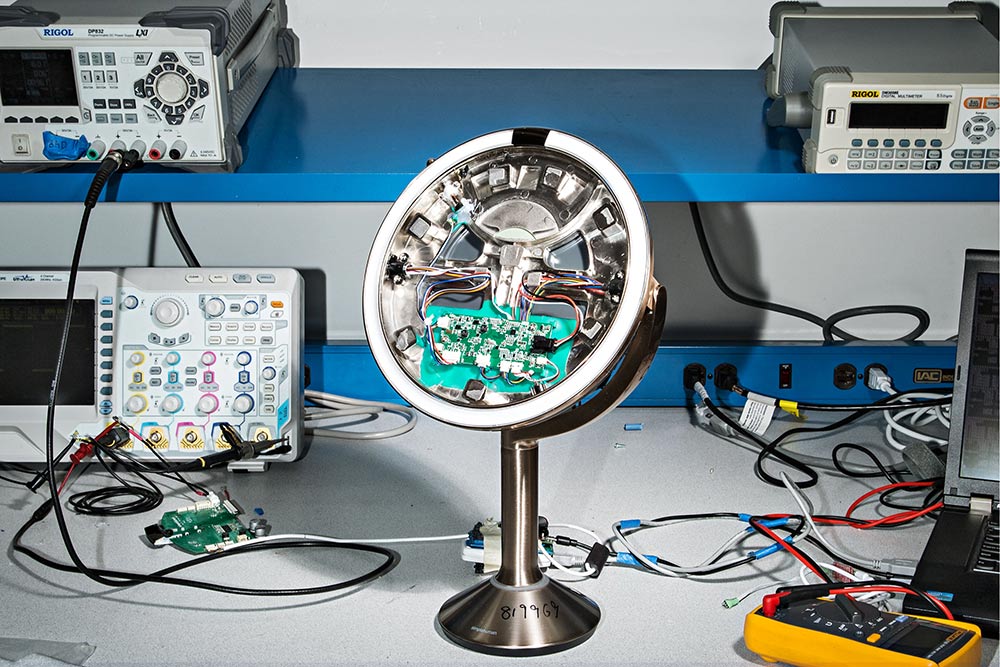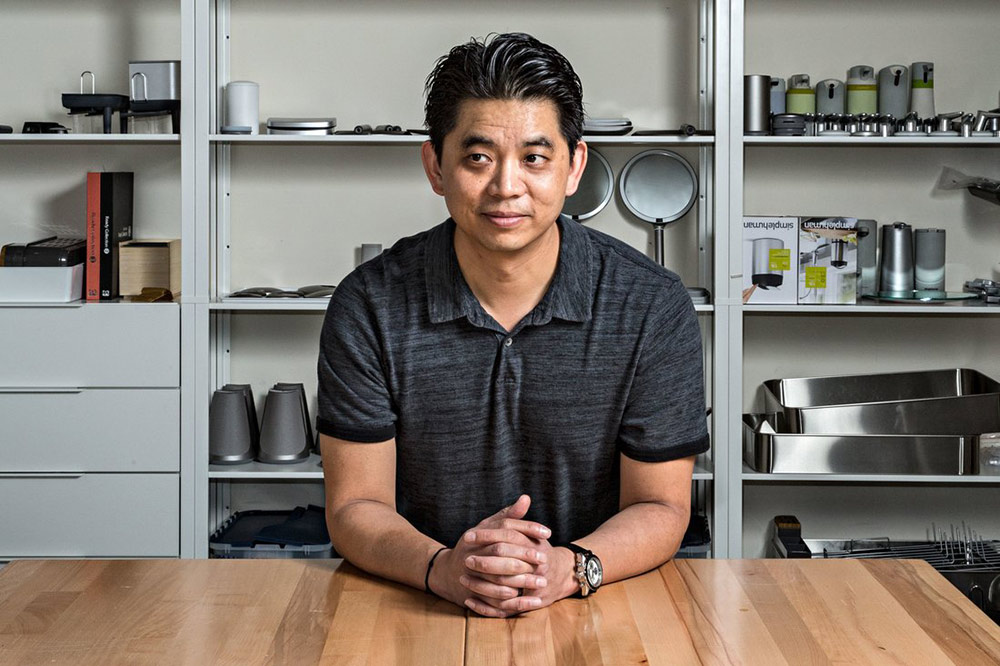这家公司被誉为“厨卫界的苹果”,创始人是位华裔

|
在美国加州托伦斯市的一个大仓库里,家居用品生产商Simplehuman的工程师们正在测试一款声控垃圾桶。测试的方法很简单,就是不断地下达声音指令,以检测其语音识别技术的可靠性。 房间的中间呈正方形排列着4个一模一样的垃圾桶。每隔10秒钟,扬声器里就传来一个机器合成的人声:“打开垃圾桶。”就这样,每隔10秒钟,这4个垃圾桶的盖子就会打开再关上。测试就这样一个小时又一个小时地重复下去。有一部摄像机会录下测试情况,以便工程师分析测试中出现的任何问题。 Simplehuman公司的CEO弗兰克·杨有点不好意思地说:“如果我们非常大声地说话,我敢肯定,其中的某个垃圾桶可能没办法正常打开。” Simplehuman又被一些人称为家居界的苹果。它生产的肥皂盒、高科技镜子、碗碟架等产品美观且实用,迅速吸引了一批忠实客户。该公司称,去年它的营收入增长了15%,超过2亿美元。 虽然厨卫产品市场的竞争十分激烈,但这依然没有阻挡Simplehuman的崛起。近年来,乐柏美和咸美顿等家居品牌都推出了廉价垃圾桶。Conair和iHome等品牌也推出了高科技增强型的镜子。 不过市场研究公司NPD集团的分析师乔·德罗科斯基认为,Simplehuman之所以能够从竞争中脱颖而出,是因为它擅于给产品做加法。去年美国家居用品市场的市值为267亿美元,较上年增长5.9%,这一增长空间几乎全部来自于高端家居产品,而非廉价产品。 德罗科斯基表示:“他们的例子说明,哪怕是对于镜子或者垃圾桶这样简单的东西,只要你肯创新,加以好的营销,你就可以做得很好。” Simplehuman的口号是“高效生活的工具”。去年春年,弗兰克·杨和他的100名员工搬进了一个开放室式办公楼。弗兰克·杨将这里称为“打造创新产品的工具”。办公区里有一个室内篮球场(弗兰克·杨压力大时就会去投篮),还有几个用于测试和调整产品的实验室。 在靠近那几个声控垃圾桶的拐角处,有一个安静的小隔间,它的墙壁是用泡沫材料做成的。弗兰克·杨打开了门,里面立即传来了艾德·希兰的《你的形状》。 两名技术人员正在测试Simplehuman的一款最新产品——一款计划于今年4月推出的hi-fi镜子。它是一面专门经过优化的化妆镜,具有5倍放大功能,光线可以多档调节(白天冷光,晚上暖光),而且底座还有一个蓝牙音箱。估计像希兰这种得过格莱美奖的音乐人一定会喜欢。 |
In the back of a big warehouse in Torrance, Calif., engineers at home-essentials maker Simplehuman are putting the company’s voice-activated trash can through its paces. The goal: to test the reliability of its voice-recognition technology by subjecting it to a sonic pummeling. Every 10 seconds, hour after hour, a robotic voice from a speaker repeats, “Open can.” And every 10 seconds, hour after hour, the lids on a quartet of trash cans, arranged in a square in the middle of the room, open and close. A camera records video so that engineers can analyze any hiccups. “If we start talking really loud, I bet one of them might fail,” Simplehuman CEO Frank Yang says coyly. Simplehuman, described by some as the Apple of housewares for its sleek soap dispensers, high-tech mirrors, and dish racks, has attracted a devoted customer base. Last year its revenue grew 15% to more than $200 million, the company says. Simplehuman’s rise comes despite stiff competition in the market for kitchen and bathroom products. Rubbermaid and Hamilton Beach produce cheaper trash cans, for instance, while Conair and iHome also churn out tech-enhanced mirrors. But Joe Derochowski, an analyst for market research firm NPD Group, says what sets Simplehuman apart is the little extra it adds to its products. Higher-end home essentials, not cheaper products, accounted for nearly all of the 5.9% growth in the $26.7 billion housewares market last year. “They’re an example of how you can take something simple like a mirror or a garbage can, innovate it, pair it with some great marketing, and do really well,” says Derochowski. Simplehuman’s slogan is “Tools for efficient living,” and last spring, Yang and his staff of 100 finished moving into what he calls a “tool for building innovative products.” It’s an open-plan office with an indoor basketball court (Yang shoots hoops when he’s stressed) and labs where Simplehuman tests and tweaks products. Around the corner from the opening and closing trash cans is a quiet booth with foam-padded walls. Yang opens the door, and Ed Sheeran’s “Shape of You” comes blasting out. Two technicians are testing the speaker attached to Simplehuman’s latest product, a hi-fi mirror that debuts this April. It’s optimized for applying makeup, with 5x magnification, different lighting options (cool for daytime, warm for evening), and—here’s that added consumer benefit—a base equipped with a Bluetooth speaker that a Grammy-winning artist like Sheeran would probably find up to snuff. |

|
弗兰克·杨表示:“我可以说是个音响发烧友。我们已经对声音做了21次优化迭代——从第17次之后,它的声音听起来还算不错了。” Simplehuman公司的员工花了8000多个小时研发这款镜子和它的发光环,以使光线能够均匀地分布在它四周。点亮它只需要手指轻轻一点,而无需扳动开关。在另一个房间里则有一个像显微镜一样的装置,它负责将线条投射到镜子表面,以校准镜子的平整度。如果线条是直的,说明这是一面好镜子。如果直线变弯了,则说明镜子的平整度有问题。 这面镜子的另一版本将于5月上市,届时它将搭载谷歌助手的语音识别功能。家居设备增添语音识别功能的风潮最早是由亚马逊的Echo带起来的,Simplehuman也非常擅于抓住流行的最新科技,同时又忠实于它的设计理念。 弗兰克·杨的父亲是一名台湾地区移民,创办了一家生产仓储设备的公司。“我为他工作了四年,然后我觉得很无聊。”于是19年前,弗兰克·杨从父亲那里借了20万美元,并且靠这笔钱创办了Simplehuman。 在家居行业,很多公司都是靠跟风别人的创意,然后把它抛给亚洲的代工厂生产,不过弗兰克·杨对这种做法并不感冒。他会认真做自己的原型产品。他的公司从2013年就有自己的3D打印机了,2016年又采购了一台电路板打印机。直到现在,他走过那台电路板打印机时,有时也会觉得头昏眼花。 弗兰克·杨表示:“这和苹果生产iPhone是一回事。怎样放一个更强大的电池进去?那你就得把别的东西造小一点,然后最终产品就可以更小,又或者……”他笑道:“你可以让它做更多的事情。”(财富中文网) 本文另一版本登载于2019年4月刊的《财富》杂志,标题为《极致措施》。 译者:朴成奎 |
“I’m a bit of an audiophile,” says Yang. “We’ve gone through 21 iterations of sound profiling—after 17, it started sounding okay.” Simplehuman’s staff spent more than 8,000 hours developing the mirror and its illuminated ring so that light is evenly distributed around its circumference. It brightens with the touch of a finger rather than the flick of a switch, and in another room, there’s a microscope-like device that projects lines onto the mirror’s surface to make sure it reflects like a mirror should: If the lines are straight, the mirror’s good; if they’re curved, it’s not. A second version of the mirror, on sale in May, comes with Google Assistant, the voice-activated helper that recites information on command. It’s an example of Simplehuman jumping on the latest tech bandwagon, popularized by smart speakers like Amazon Echo, while keeping true to its design philosophy. Yang started Simplehuman 19 years ago with a $200,000 loan from his father, a Taiwanese immigrant who founded a company that makes storage units. “I worked with him for four years, and I got so bored,’” Yang says. Unenthused by the idea of simply mocking up a new product and sending it to a factory in Asia to fabricate, as some of his competitors do, Yang builds his own prototypes. His company has owned 3D printers since 2013 and a circuit-board printer since 2016. Even now, he gets giddy when he walks by it. “It’s the same game as the iPhone,” Yang says. “How do you put in a more powerful battery? You have to make other stuff smaller, and then the end product can be smaller, or”—he smiles—“you can make it do more things.” A version of this article appears in the April 2019 issue of Fortune with the headline “Extreme Measures.” |













